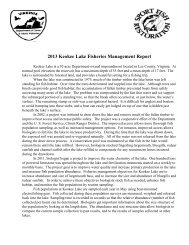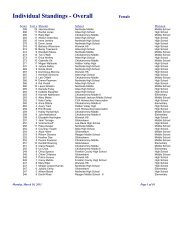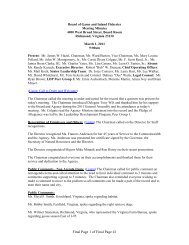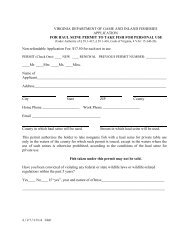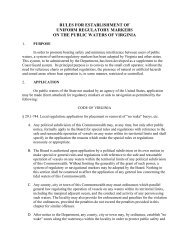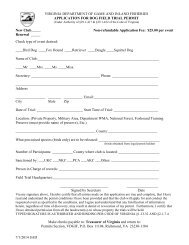2013 Virginia Freshwater Fishing & Watercraft Owner's Guide
2013 Virginia Freshwater Fishing & Watercraft Owner's Guide
2013 Virginia Freshwater Fishing & Watercraft Owner's Guide
Create successful ePaper yourself
Turn your PDF publications into a flip-book with our unique Google optimized e-Paper software.
<strong>2013</strong> <strong>Fishing</strong> Regs & WOG 11-15-12_Layout 1 11/16/12 1:02 PM Page 63MEETING (HEAD-ON) SITUATIONSPassingPort to PortPassingStarboard toStarboardMeeting Headto Head1 short blast**2 short blasts**50’ Rule*1 short blast**2 short blasts**50’ Rule*1 short blast**1 short blast**Stand-On vesselholds courseand speedCROSSING SITUATIONDANGER ZONE50’ Rule*50’ RuleOVERTAKING SITUATIONInland RulesI want to go around you on yourport side - 2 short blasts**Proceed2 short blasts**GIVE-WAYvesselovertakingInland RulesI want to go aroundyour on your starboardside - 1 short blast*Proceed1 short blast**50’ Rule*50’ Rule*STAND-ONvessel holdscourseand speed50’ Rule1 short blast*** A PWC must slow to no wake speedif within 50’ of a motorboatSOUND SIGNALSShort blast=a blast of about one second’s duration3 short blasts indicates a motorboat operating astern propulsion5 short blasts is the danger signal** Not sounded on international watersPortStarboardGIVE-WAY vessel alters course1 short blast**Head-on (bow to bow)When two power-driven vessels are meetinghead-on or nearly head-on, each shallalter her course to starboard (right) so thateach shall pass on the port side of the other.A head-on situation exists when a vesselsees the other ahead or nearly ahead and bynight she could see the masthead lights ofthe other in a line or nearly in a line or bothsidelights.Giveway and Stand-on VesselsGive-way and Stand-on is the terminologyused to describe the appropriate actionof each vessel in crossing and passingsituations.The “give-way” vessel is the vessel thatmust take early and substantial action tokeep well clear of another vessel.The “stand-on” vessel shall maintaincourse and speed unless it becomes apparentthat the vessel required to keep out ofthe way (the “give-way” vessel) is not takingthe appropriate action. If the stand-on vesselmust take action to avoid a collision, itmust avoid turning to port for a vessel onher port side.An action taken to avoid a collision needsto be positive, made in ample time and largeenough to be apparent to the other vessel. Ifnecessary to avoid a collision or allow moretime to assess the situation, a vessel mustslacken her speed or take all way off by stoppingor reversing engines.Power boats must give-way to sailingvessels under sail regardless of the angle thepower-driven vessel approaches the sailingvessel.CrossingWhen two power-driven vessels are crossing,the vessel which has the other on herstarboard side shall give way and keep out ofthe way and avoid crossing ahead (in front)of the other vessel.When taking action to stay out of theway, make it early, substantial and well clearof the other boat. Avoid making a successionof small alterations of course or speed. If youare directed by the Rules to stay out of theway, then make your turn large and obviousso as to be readily apparent to another vesselboth visually or by radar. This is especiallytrue at night, when the only visual indicationof your course change is the alteration ofyour boat's lights.OvertakingAny vessel overtaking any other shall givewayand keep out of the way of the vesselbeing overtaken.When a vessel is in any doubt as towhether it is overtaking another, it shallassume that this is the case and act accordingly.If you are being overtaken (passed), youare the stand-on vessel and should maintainyour course and speed. The vessel over -taking you should notify an intent to pass bymaking an appropriate sound signal. Oneshort blast of the horn or whistle means “Iintend to overtake you on your starboardside” and 2-short blasts means “I intend toovertake you on your port side”.When two sailing vessels are approachingone another in a crossing situation, one ofthem shall keep out of the way of the otheras follows:• When each has the wind on a differentside, the vessel which has the wind onthe port side shall keep out of the way ofthe other;• When both have the wind on the sameside, the vessel which is to windwardshall keep out of the way of the vesselwhich is to leeward; and• If a vessel with the wind on the port sidesees a vessel to windward and cannotdetermine with certainty whether theother vessel has the wind on the port oron the starboard side, she shall keep outof the way of the other.Windward side is deemed to be the sideopposite to that on which the main-sail iscarried.Responsibility BetweenVesselsExcept where otherwise required:A power-driven vessel shall keep outof the way of:• A vessel not under command• A vessel restricted in her ability tomaneuver, such as a tug boat or deepdraftfreighter• A vessel engaged in commercial fishing• A sailing vesselA sailing vessel shall keep out of theway of:• A vessel not under command• A vessel restricted in her ability tomaneuver, such as a tug boat or deepdraftfreighter• A vessel engaged in commercial fishing63



